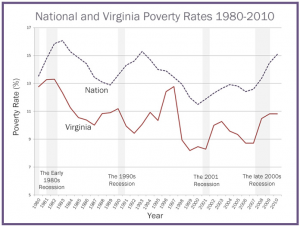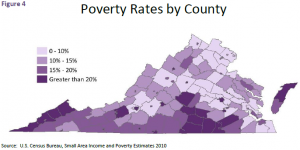Over the past 30 years, Virginia has consistently logged a lower incidence of poverty than the United States as a whole, as seen in this graphic published by the Weldon Cooper Center for Public Service.
But broad measures of poverty don’t tell the whole story. In “Poverty and the Social Safety Net: Who Are Virginia’s Poor?” Dustin A. Cable and Rebecca M. Tippett provide a more detailed statistical portrait of poverty in the Old Dominion.
The authors distinguish between different levels of poverty. Deep poverty (incomes half or less than the poverty rate) comprise 5.1% of the state population; 10.8% of Virginians can be classified as poor (under the poverty line), and 17.2% can be classified as “in or near poverty” (under 150% of the poverty line).
Cable and Tippett also note that Americans move in and out of poverty, depending upon circumstances: 51% of Americans experienced at least one year of poverty, while 30% have experienced deep poverty.
In Virginia, poverty is concentrated in inner cities jurisdictions like Norfolk, Richmond and Portsmouth and rural regions such as Eastern Shore, the Southwest and Southside.
Poverty is highest among children and lowest among working-age adults, with elderly adults in between. Blacks have the highest poverty rate (20%), followed by Hispanics (12.4%), whites (8.1%) and Asians (7.3%).
What this study doesn’t tell us is why Virginia has a lower rate of poverty than other states, and why poverty is distributed among ages, ethnicities and geographic groups the way it is. Presumably, there is a relationship between poverty and unemployment. Virginia’s unemployment rate is consistently lower than the national average. Is that a reflection of a stronger economy with greater job creation, or is it possible that tighter-fisted social safety net funding encourages poor Virginians to get out and look for jobs? Another question: To what extent are Virginians trapped in a culture of poverty and dependency, and to what extent are they victim of circumstances such as layoffs? Those are the questions we really need to be asking.
Cable and Tippett did dig deeper in a companion piece, “The Role of the Social Safety Net in Virginia,” in which they show how Social Security, Medicare and means-tested wealth transfers play a significant role in lowering the poverty rate. But they don’t address the questions that I ask.
— JAB




